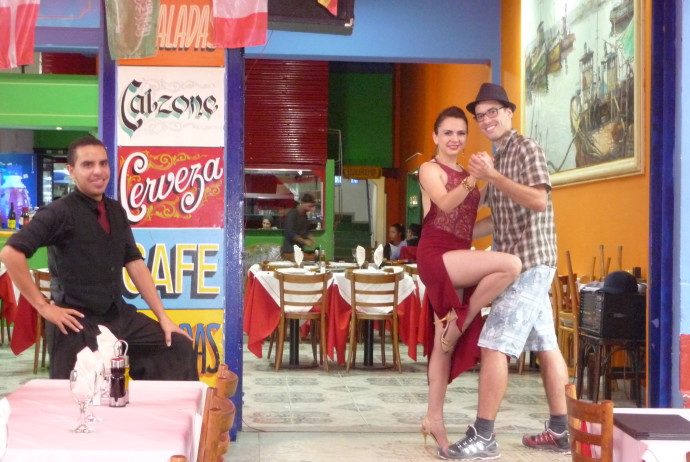Despite the 20 hours bus ride that took us to Bueos Aires, we arrived rather fit and of course already hungry for some Argentinian steaks. On our first day we strolled through the various parks of Palermo, a rather fancy neighborhood of Buenos Aires. This turned out to be quite a hiking training as every time we got out of one park, there was another one waiting on the opposite side of the street. If it hadn’t been for these up to 18 lane streets seperating the parks we wouldn’t even have guessed that Buenos Aires was a city of more than 3 million inhabitants.
The next day we set out to see some more of the city’s “barrios” (neighborhoods). We started our tour in Puerto Madero, a charming part of town, which combines elements of an old harbor with modern architecture. Just a few blocks away we then found our most favorite place of Buenos Aires: the “Reserva Ecológica de Buenos Aires”. Here crocodiles roam while locals have picnics on the shores of Rio de la Plata.
Eager to accustom to local habits, we went for a late dinner. So by the time we got the menu, we were starving and we were only stopped from ordering 1kg of steak each by the server’s horrified protest. In the end, we shared only 2kg of delicious steaks, grilled to perfection on the parrillada (that is the typical grill every trustworthy Argentinian restaurant must have for any reasonable meatlover to enter it). After dinner, we just had to follow the crowds on the streets to arrive at Plaza Serrano, a square full of busy restaurants, bars and clubs. Despite our late dinner, we were still too early, as most Porteños (that are the locals of Buenos Aires) were just ordering their dinners. Nevertheless, we happily barhopped our way around Plaza Serrano.
The next day, feeling slightly awkward, we went to see the city’s most famous attraction, the cemetary in Recoleta. This used to be THE place to be buried for anyone who could afford to build a little palast instead of a tomb stone and furthermore apprectiated to be “visited” by thousands of people every day. We strolled through the alleys of impressive but sometimes also slightly scary tombs, trying, like everybody else, to find the grave of the famous Evita – Eva Peron Duarte. We had expected this to be easy, however, the guidebook’s advice to “follow the crowds”, turned out not be very helpful. Probably due to the dim weather, we did not find any crowds to follow and everybody we asked seemed to run after someone else until finding out that that person was just as lost. Eventually though, we not only stumbled upon the grave but had also made new friends during our awkward “treasure hunt”. In order to make it easier for you, if you ever look for it, here are the coordinates: -34.588355, -58.393738
As it was Sunday, our next stop was Plaza Dorrego in San Telmo, where a weekly market attracts many tourists who, like us, walked through the numerous stands where artisanal work is sold along with an array of antique pots and other stuff which we “sadly” had no room for in our backpacks. Thus, we moved on and for the rest of the day strolled along the “caminito” in La Boca, a purly touritsty but still cheerful part of town. After having a beer while learning some Tango moves, we all were ready for “homemade” steaks – and really, the meat here is so good, even the three of us were not able to mess it up!
Colonia del Sacramento is a picturesque town in Uruguay and luckily only a 1h speed boat ride away from Buenos Aires. Thus, we took our chance to touch down on Uruguaian soil and went there. Apart from cafés, restaurants and bars there is not much there. Nevertheless, we had an awesome, relaxing day just laying in the sun on the shores of Rio de la Plata, the interesting colored body of water shared by Argentina and Uruguay which sparkles in all shades of brown. Furthermore, we not only tried some Uruguain steaks and wine but also, for the first time, some maté. Drinking maté, which is immensly popular in numerous South American countries, is not at all comparable to having a normal cup of tea. It is a highly complicated ritual which we still haven’t managed to conduct to perfection, but we are working on it. Maté itself is a very strong herbal tea which is quite bitter. In fact it is so bitter, that it only starts tasting really good if consumed in combination with Alfajores, the wonderful but super sweet cookies found in every shop in Argentina and Uruguay. These cookies have been an important part of our diet ever since entering Argentina and we are seriously considering to open an import business in Europe. But back to our story: so upon returning to Buenos Aires, we already had to get ready for our next destination: Patagonia!!!
When in Buenos Aires
Where to sleep: Alvear Palace Hotel – here’s a place you can stay in if you have more money than us – we saw it, fell in love with it and hope that one day we earn enough to afford it! 🙂
Where to eat & drink: La Choza – premium steaks and huge portions at fair prices in the heart of Palermo. La Confitería Ideal – good place to enjoy a Tango show.
What to see: Reserva Ecológica de Buenos Aires – here you can take a break from the big city life of Buenos Aires.
